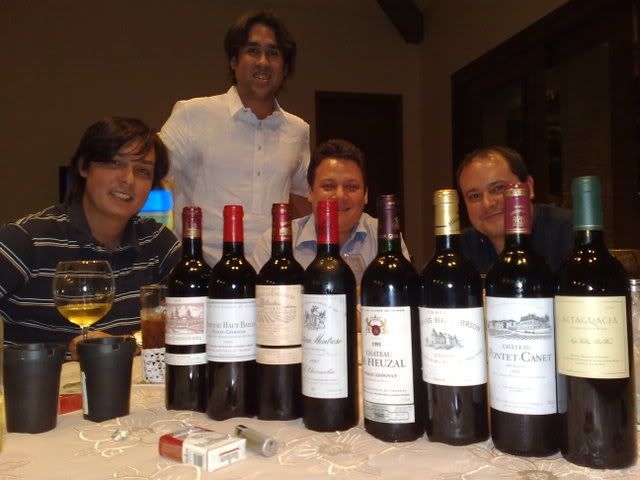
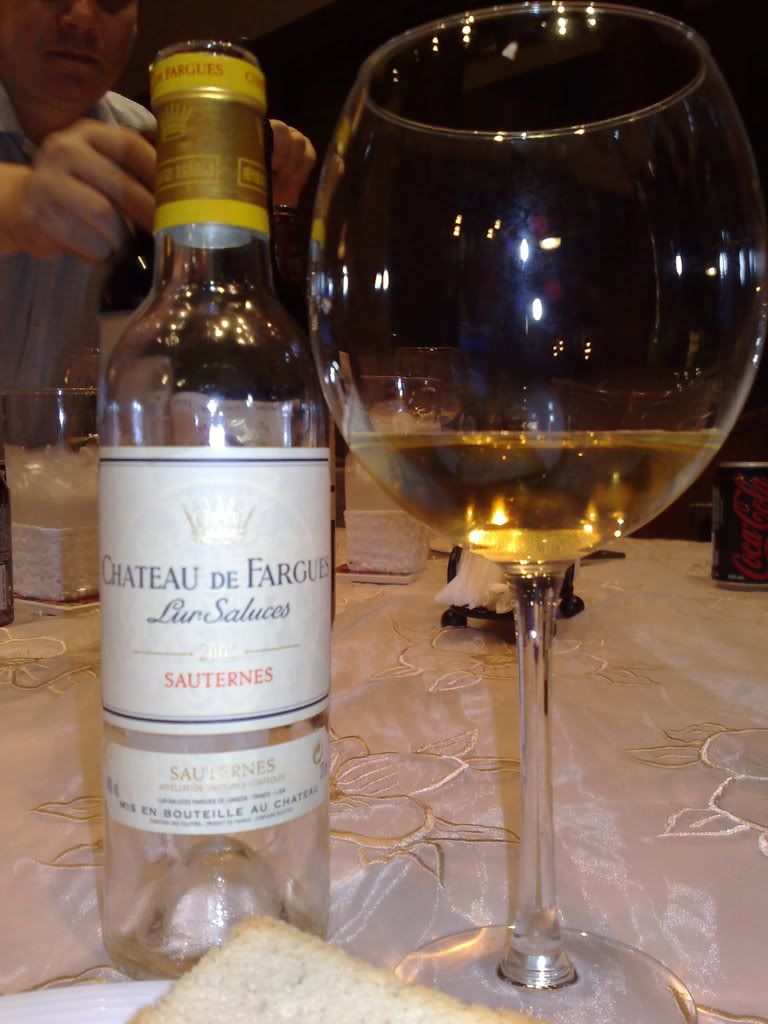 Not wasting any time, to pair with a pâté en terrine of foie gras, Santi broke out a half bottle of 2002 Château de Fargues - from a Sauternes estate of which few people are aware has been owned and run since the late 1700s by the Lur Saluces family of d'Yquem fame. The oldest de Fargues I've had to my immediate recollection was a sublime 1986, enjoyed 3 years ago (See: my old notes).
Not wasting any time, to pair with a pâté en terrine of foie gras, Santi broke out a half bottle of 2002 Château de Fargues - from a Sauternes estate of which few people are aware has been owned and run since the late 1700s by the Lur Saluces family of d'Yquem fame. The oldest de Fargues I've had to my immediate recollection was a sublime 1986, enjoyed 3 years ago (See: my old notes).Though it has a lot of maturing to do, this lass is a precocious one; supple with a teen-ager's taut, lithe body and youthfully seductive curves (think Natalie Portman's character in the movie "Closer").
Notes of orange marmalade, orange rind, ripe peach/apricot compote over a slight undertone of crème brûlée are displayed with just enough acid, spiciness and botrytis tang to save the palate from early fatigue.
Lovely, but now I'm going to have to find that DVD of Closer somewhere in the baskets of other videos in my room....With hot-off-the-grill slices of chuleton (with the luscious, irresistible fringes of toasted, life-enriching fat) and various side dishes (scalloped potatoes, marinated peppers, sautéed mushrooms, etc.) , we then moved on to the reds:
1995 Château de Fieuzal (Pessac-Léognan) - My bottle, reputedly the best produced by de Fieuzal before the advent of vintage 2000. I last had this wine over 5 years ago and was very curious how it was coming along. I mentally compared it to the 1996, which is drinking superbly:
Already a lot of bottle-age sweetness to this
medium-bordering-on-full-bodied, ripe, red currant-and-kirsch-laced,
cassis/tar/earth dominant wine with finely knit, with a vaguely smoky, sweetish
roasted herbs and cedar surfacing mid-mouth and following through on the
finish.
The 1995, while holding true to its terroir with typical roasted herbs, mild earthiness and smokiness to the cedar and discreet tar/tobacco notes, lacked the forward sweetish red currant/kirsch push of the 1996 (it was more dominated by dark fruit) and had noticeably less balancing acidity, which, to me, made the former marginally less alluring. I think the 1995 is definitely a good wine, but expected more from it, given its reputation and my fascination with its 1996 counterpart. This just bolsters my (and many others') opinion that the 1996s are definitely better (virtually across the board) than 1995s . At this stage, anyway.
1995 Château Montrose (2nd Growth, 1855, St-Estèphe) - Santi's bottle, chosen by me to compare with the de Fieuzal of the same vintage. I am certain I've had this wine within the last year, but simply cannot find any notes of mine on it. The last I recall clearly was at our beach house during summer around 5 years ago and thinking it was way too young and closed.
In any event, Santi noted that, while the wine was initially reticent, it opened up well around two hours later (he's learned a lot and fast, that one has). Montrose has long been a favored château, it has consistently high quality and can, in good years and after proper age, be powerful yet contemplative as well.
This Montrose was typically masculine, a touch stern and austere, with notes of leather and smoky cedar to its earthy dominant dark fruit and cassis. This is classic St-Estèphe, this Montrose held true and proud to its origins. I thought this and, next, the de Fieuzal paired best with the steaks. This 1995 is more ready to drink than their 1996, I can't think of many wines I could say the same thing for.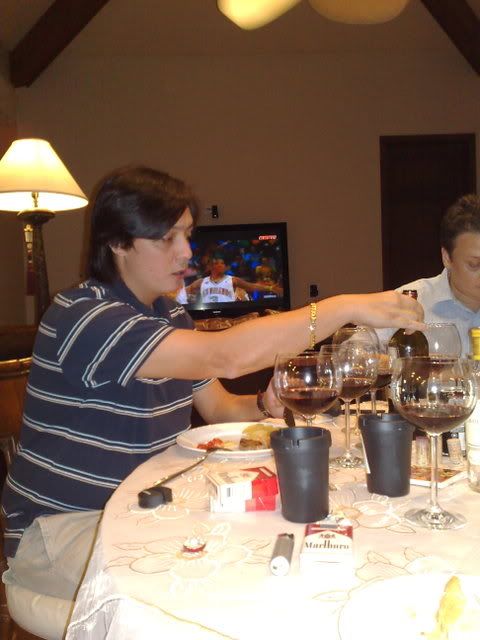 1998 Château La Couspaude (Grand Cru Classé, St-Emilion) - I brought this merlot-dominant wine thinking it would be a nice counterpoint to the left-banks and to pair with the steak. This wine gave me my first win in our regular Mini Blind Bordeaux Challenges so I wanted my friends to try this "giant-killer". All my past bottles of this wine displayed wide-open, generous, almost wanton vanilla/oak-infused, unctuous sweet ripe plum, kirsch, violets, espresso and chocolate profiles on a crowd-pleasing, low acid medium-to-full body.
1998 Château La Couspaude (Grand Cru Classé, St-Emilion) - I brought this merlot-dominant wine thinking it would be a nice counterpoint to the left-banks and to pair with the steak. This wine gave me my first win in our regular Mini Blind Bordeaux Challenges so I wanted my friends to try this "giant-killer". All my past bottles of this wine displayed wide-open, generous, almost wanton vanilla/oak-infused, unctuous sweet ripe plum, kirsch, violets, espresso and chocolate profiles on a crowd-pleasing, low acid medium-to-full body.
Unfortunately, this bottle was mildly corked - with a slight hint of of mustiness and plastic and none of the flamboyancy of a healthy bottle. It was still drinkable, but, after a few polite "consolation sips", everyone set their glasses aside - as well they should. There is no reason to plod through a bottle of even mildly corked wine.
Quite disappointing, but, these things happen. Too bad, I really wanted them to be able to try this wine.
 1999 Château Cos d'Estournel (2nd Growth, 1855, St-Estèphe) - Miguel's bottle, and, for me, the wine of the night. I had earlier mentioned to them that most all the dinners I've attended in Bordeaux (in 2006 and 2007) featured the host château's 1999 vintage (e.g., Siran, Léoville Poyferré and d'Issan; plus the 1999 Poujeaux at the recent Commanderie dinner in HK) before moving to far older vintages.
1999 Château Cos d'Estournel (2nd Growth, 1855, St-Estèphe) - Miguel's bottle, and, for me, the wine of the night. I had earlier mentioned to them that most all the dinners I've attended in Bordeaux (in 2006 and 2007) featured the host château's 1999 vintage (e.g., Siran, Léoville Poyferré and d'Issan; plus the 1999 Poujeaux at the recent Commanderie dinner in HK) before moving to far older vintages.Cos d'Estournel is widely regarded as the top of the St-Estèphe heirarchy. There are no 1st growths in St-Estèphe - the commune being "ruled" by two 2nd growths: namely, Cos and Montrose.
Some professional reviewers (like Hugh Johnson) opine, however, (and I agree) that Montrose is more expressive of the appellation's terroir. Be it as it may, Cos is an eccentric, exotic château (with a curious Chinoise pagoda on the estate) that makes a wine virtually sui generis with Asian/Indian spice and Chinese tea notes that make it seductively alluring and marginally easier to identify in blind tastings.
This Cos is well extracted and ripe for its vintage, with telltale traces of its signature Asian spice and tea leaf, touch of soy in its nose and on the back-end of the palate, exquisitely woven into the smoky cassis, cherry, licorice, touch of fig and mildly spiced oak. It needed virtually no aeration to display its favors, it just sang out of the bottle. Good confidence and command without being over-bearing, it put on a solid, definitive and memorable performance. Bravo.
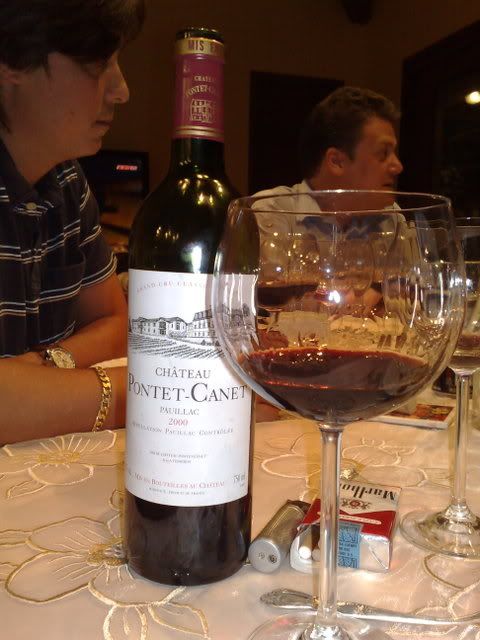 2000 Château Pontet-Canet (5th Growth, 1855, Pauillac) - Chris' bottle, one I had never tried before. This was the young bruiser of the bunch, eagerly unleashing rolling muscle under a lush, ripe, almost velvety glove. Black fruit, cassis over licorice dominated with hints of red cherry, gravel and minerals in a long and strong finish. Good, sturdy bones in this. Impressive for a barely 8 year-old Pauillac, I 'd surely like to try this again in 3 years' time and follow its evolution over the next 20 years.
2000 Château Pontet-Canet (5th Growth, 1855, Pauillac) - Chris' bottle, one I had never tried before. This was the young bruiser of the bunch, eagerly unleashing rolling muscle under a lush, ripe, almost velvety glove. Black fruit, cassis over licorice dominated with hints of red cherry, gravel and minerals in a long and strong finish. Good, sturdy bones in this. Impressive for a barely 8 year-old Pauillac, I 'd surely like to try this again in 3 years' time and follow its evolution over the next 20 years.
I suspect this will age nicely (it certainly appears to have the structure for it), the red cherries surfacing more in time and the wine turning subtle and sweeter in 10 years from now.
Though I expected this to be too young to really be enjoyable at this point, I suppose my experience with the 2001 vintage around 2-3 years ago caused me to think this of the 2000 before I tried it. I am happy to admit that I was wrong. Were it that all my mistakes were this pleasurable.
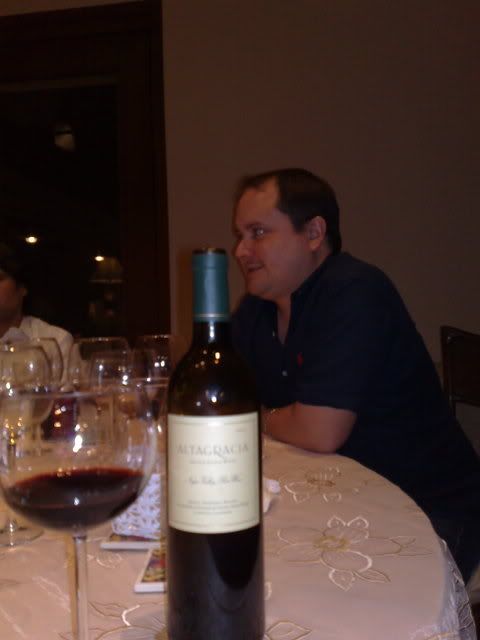
2000 Altagracia (Napa) - Rene's bottle, opened to compare styles and characteristics of origin. I remember it to be a vintage 2000, please correct me if I am wrong. As I understand it, this is the second wine of the cult Napa, Araujo. I've never tried an Araujo, so really didn't know what to expect. Having repeatedly tried a few cult Napa cabs due to the generosity of one-who-cannot-be-named (e.g., Screaming Eagle, Harlan, Bryant Family, etc.), I know well that not all "killer" Napa cabs are over-wrought, contrived, blocky and cumbersome. After all, I, the Doc and Edouard have repeatedly mis-identified well-aged bottles of Dominus from the Stockbroker.
This wine, though, young, was already quite enjoyable. It does not appear to be from the "the bigger, the better" school of wine-making. Though I would certainly not mistake it for Bordeaux or Old World, it does not display the over-bearing, syrupy consistency, tons of oak or telltale coconut-creamy/sweet butterscotch smell of a typical, big napa cab. Rather, it shows comparative restraint (a good thing for me) without sacrificing the straightforward honesty and rich flavors of its its kind.
Big (but not blocky), rich (but not ostentatious), this wine shows off its comparatively viscous, sweetishly ripe molten black fruit, mere hint of pruniness, crème de cassis, licorice, touch of toffee and sweet tobacco with some refinement. I thought it was a nice touch to throw a Napa into the mix. While my heart hopelessly belongs to Bordeaux, the palate can only take so much at one sitting. This wine kept things interesting. As Dr. Lecter quoted his mother in the closing scene of "Hannibal": "It is always good to try new things".
Many thanks, guys. It was a lot of fun. I look forward to the next.
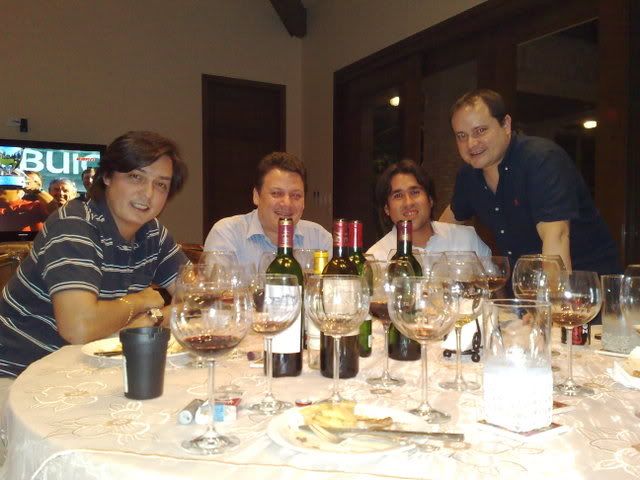




2 comments:
It was a good night. Til next month !
And yes the Altagracia was a 2000.
Thanks,M, and for sharing the '99 Cos. I'm pretty sure I'd not tried it before. Very nice. ¡Hasta entonces!
Noel
Post a Comment